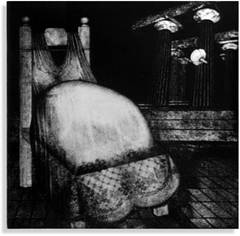| Ragnheidur Jónsdóttir |
 |
 |
|
|
by Ólafur Kvaran
Stronger social criticism is found in the graphics of Ragnheiður Jónsdóttir, who made her debut at the end of the 1960s. Early on, she tended to work with a play of sensitive lines in underfined spaces, but later her forms grew increasingly organic and acquired a psychological dimension hinting concepts like alienation and insecurity, which became her key themes during the 1970s. The picture series ‘2001-2006’ is from 1974, a time when the idiom of her art was changing in many ways. She started then to rely extensively on solid, distingt forms while two important symbols appeared that would recur in most of her subsequent sets.
One of these images in the chair, standing variously for isolation, protection and helplessness. The second, one that might be called the tulip form, is a curved shape symbolizing, above all, nature and organic environment. In her picture sets, the artist frequently juxtaposes contrasting symbols; the tulip form becomes a subject of sorts when it appears in isolation - in a pot, for example - instead of being part of humanized surroundings. But, after all, people are entrusted with stewardship over nature, and the series ‘Leaders of the People 2001’ deals with environmental pollution and lack of social responsibility. Even so, these works do not just paint a doomsday picture of an irresponsible consumer society; it is also pointed out that the causes of the problem are built into the socio-economic system, a subject addressed in ‘The Leaders’. That etching shows a group of blindfolded men, representing social forces that irresponsibly turn blind eyes to realities. It is symbol of an impersonal system bent on profit making, while neglecting social responsibilities.
Taide 77 Nordiska Bilder, Finland
|
|
|
|
|
|
|
|